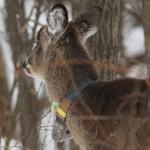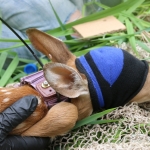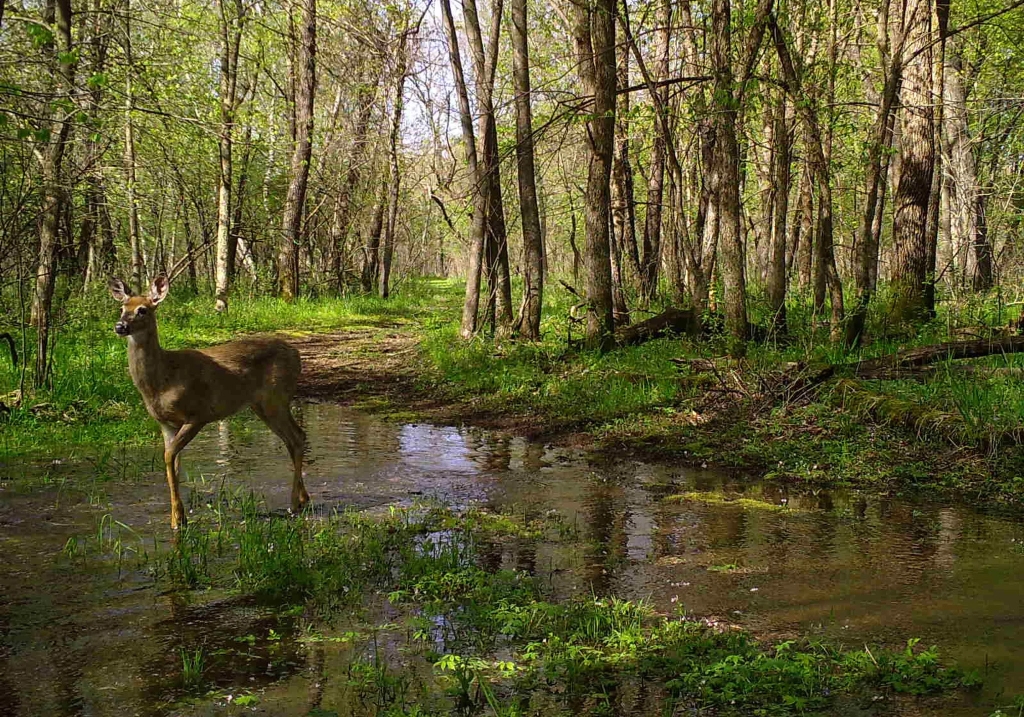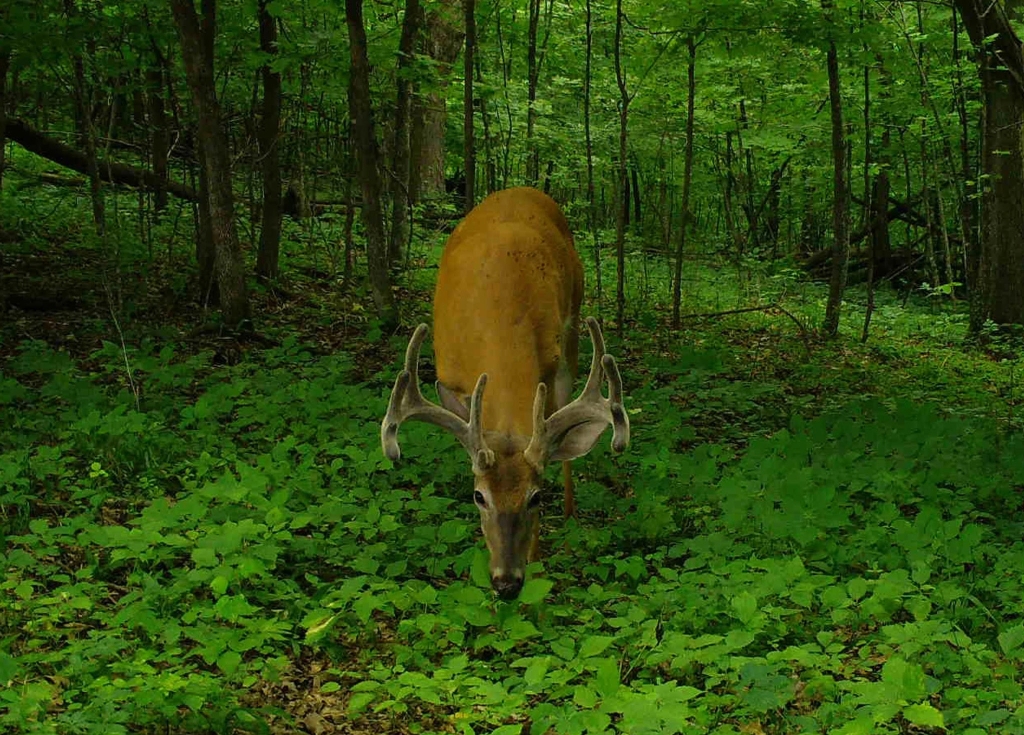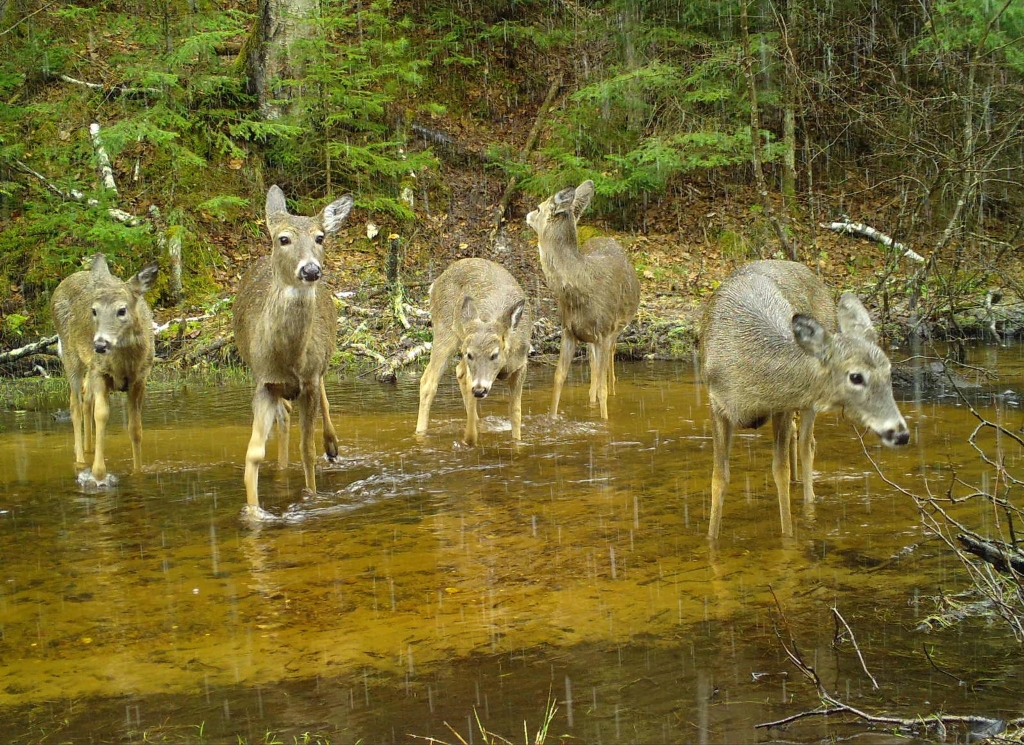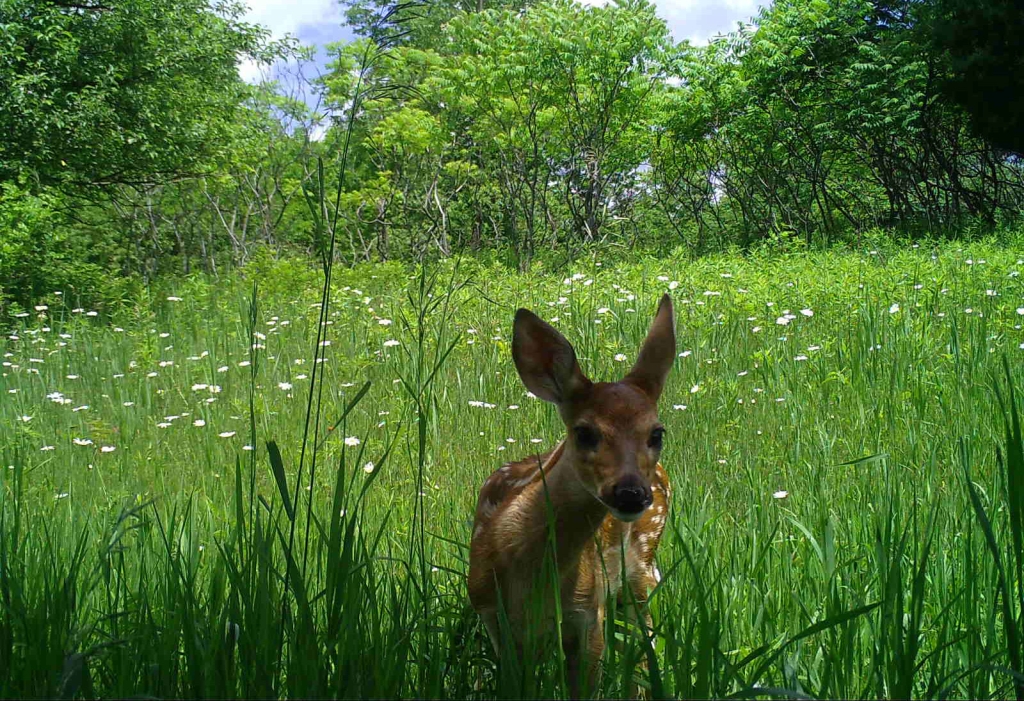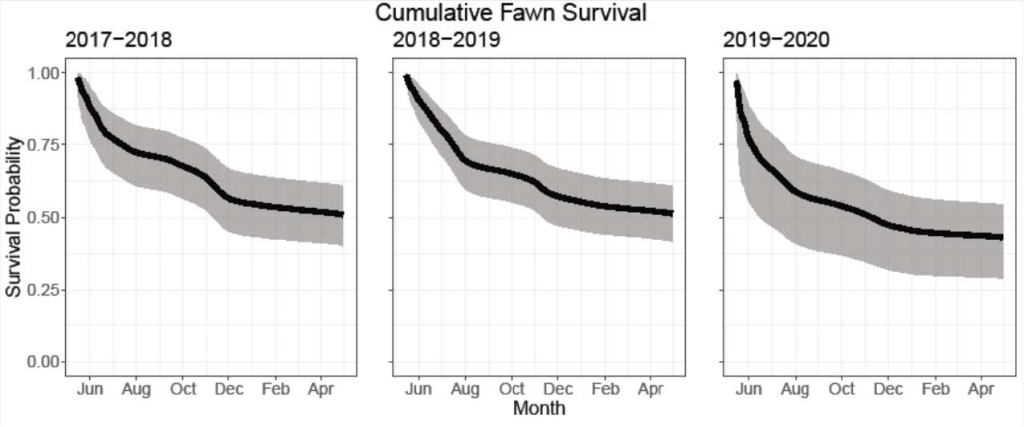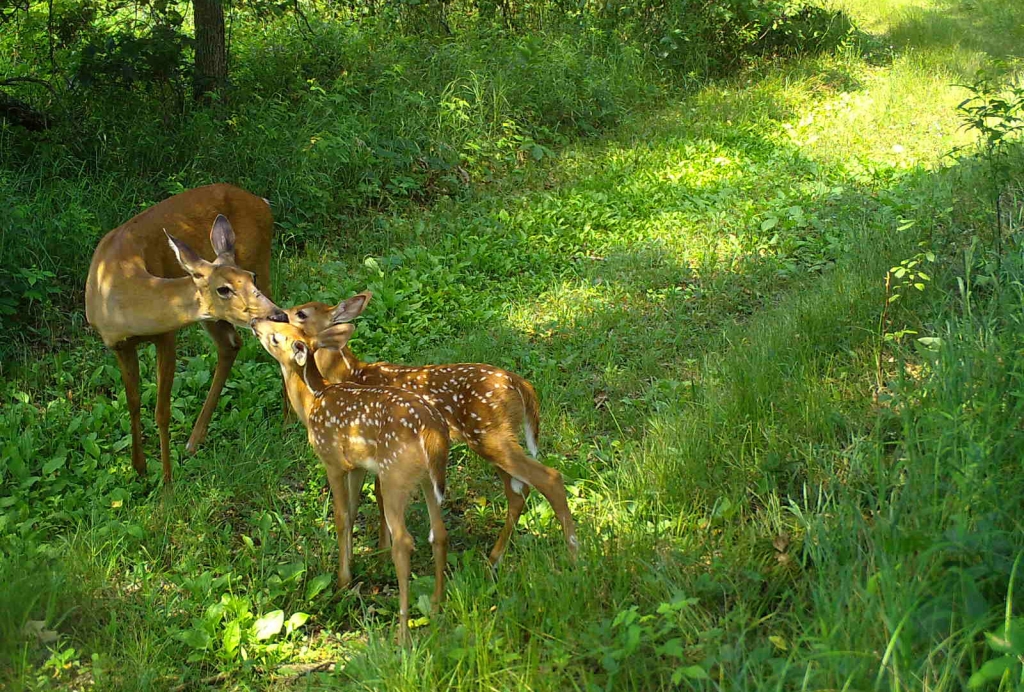April 2022
The Southwest Wisconsin CWD, Deer and Predator Study (SW CWD Study) is still churning away, analyzing data and learning about chronic wasting disease (CWD) and our deer population. In the last edition of this newsletter, the research team shared results from coyote survival and cause-specific mortality.
In this edition, the research team has two more analyses ready to share. The first is a recap of what we’ve learned from our evaluation of the deceased collared deer in the research area. We looked at what caused deer mortality and how those causes interacted with CWD.
The second analysis focuses on fawn survival, including survival rates and cause-specific mortality results. We’ve been monitoring the fates of 323 collared fawns over the course of this study, learning about how and why fawns die. From this data, we can better understand how CWD affects Wisconsin’s deer population.
ADULT DEER NECROPSY - LEARNING HOW CWD IS AFFECTING DEER IN WISCONSIN
Dr. Marie Gilbertson (who you met in the last newsletter) and Dr. Marie Pinkerton share the results of the adult deer necropsies and the roles that CWD and other diseases play in deer mortality.
ANOTHER PIECE TO THE PUZZLE - LEARNING MORE ABOUT FAWN SURVIVAL
Researcher and SW CWD Study project leader Dan Storm discuss what the team has learned about fawn survival from the 323 fawns collared for the study.
Adult Deer Necropsy - Learning How CWD Is Affecting Deer In Wisconsin
The first analysis that the research team is ready to share in this newsletter was an investigation into what caused the death of deer in our study, especially as they contract and develop CWD infections.
We know CWD-positive deer eventually become emaciated and lethargic, but that knowledge comes from observations of behaviors. Less is known about the physical changes that occur during a CWD infection and what other issues or diseases develop. This portion of the SW CWD Study is the first concerted effort of its kind to understand what CWD does to deer physically.
Since the deer are radio-collared, we know when and where they die and can retrieve the body for study. This study presented a rare opportunity to look at how CWD affects deer physically and how CWD interacts with other diseases. However, we needed the help of two specialists, coincidentally both named Marie. The first Marie is Dr. Marie Pinkerton, Clinical Professor of Anatomic Pathology at the University of Wisconsin-Madison. Pinkerton has been a board-certified veterinary anatomic pathologist since 2004 and has performed countless necropsies. She is a true expert in animal physiology and disease and the perfect person to tell us what is happening.
The second Marie is Dr. Marie Gilbertson, a post-doctoral researcher in the Wisconsin Cooperative Wildlife Research Unit at the University of Wisconsin-Madison. Gilbertson’s main role is to analyze the massive deer movement dataset gathered from the GPS collars of the study’s deer population. Still, she also took the lead in analyzing the data in Pinkerton’s necropsy reports.
Together, Pinkerton and Gilbertson tag-teamed this investigation, with Pinkerton handling the necropsies while Gilbertson analyzed the reports. Both have earned their Doctor of Veterinary Medicine, and Gilbertson has also earned her Ph.D., where she studied viruses in the endangered Florida Panther. These experts shared their findings (below) and gave their thoughts on how it changes our understanding of CWD.
What Is A Necropsy, And What Can We Learn From Them?
Scientists and veterinarians often refer to the post-mortem investigation that Pinkerton did as a necropsy. Necropsies are similar to the autopsies we see in crime shows on TV. Both terms can be used synonymously, but experts typically restrict the term autopsy to humans while necropsies refer to animals. Although, Pinkerton and Gilbertson both said to think of necropsies as “animal autopsies.”
Gilbertson explained how necropsies work. “Our objective is to [search] through every organ system in the carcass and look for abnormalities. We record all the abnormalities we find, describing the size of lesions, the locations, the colors, characteristics, etc. We [then] draw a conclusion about what we think killed the animal.”
A Large Sample Size
Of the 1,000+ deer we collared for this study, 61% have died. Another 26% have had a collar failure of some kind, and approximately 13% are still alive and transmitting movement data to the research team.
Thirty-four percent of mortalities were from hunter harvest and were not included in this analysis. Nearly all (>95%) of the remaining unharvested deer were found by staff and given a necropsy, depending on the state of the carcass.
In total, staff evaluated 433 deer mortalities, and 141 deer were sent to the lab for a full necropsy. Another 116 deer were partially decayed or consumed, so the necropsies were performed in the field. The remaining 176 deer were too decayed or consumed for a field necropsy, but staff still recorded what limited information they could about the deer’s death.
Gilbertson said, “To help put this number in perspective, my graduate work was on an endangered mountain lion subspecies with only about 200 individuals in the wild, so having this wealth of data is incredible. Having so many necropsies is very informative and creates a large sample size.”
When all the necropsy reports were completed, Gilbertson took over and analyzed the data in Pinkerton’s reports.
Summarizing The Necropsy Results
Of all deer necropsied, 42% were CWD-positive. CWD-positive deer were much more likely to be emaciated (severely starved) and were more likely to have noticeable ectoparasites (such as lice and ticks) on their bodies. Pinkerton classified over 75% of CWD-positive deer as being in poor nutritional condition.
There were several other abnormalities and diseases noted by Pinkerton across all the necropsied deer. Thirty-six percent of all deer had some form of gastrointestinal disease, and 23% had noticeable ticks or lice. Lungworms and microscopic muscle cysts were found in 46% and 65% (respectively) of the deer necropsied. Gilbertson noted that many of these other diseases were minor cases and likely were not the cause of death.
However, in this study, Gilbertson found evidence of a relationship between CWD and ectoparasites like lice and ticks. “There are several reasons we might see a connection between CWD and ectoparasites,” explained Gilbertson. “If a deer is nutritionally deprived, it might not have the energy to hang out with the rest of its herd. Or maybe it tried to, but the other deer didn’t want to hang out with it because it looked sick. This matters because deer within social groups groom each other, removing ectoparasites in the process, so this finding may indicate a change in deer behavior. I see an inkling of something interesting going on here and think it’s worth looking into more!”
Comparing Necropsied CWD-Negative And CWD-Positive Deer
Another striking result from the necropsy reports is the physical difference between CWD-positive and CWD-negative deer. Pinkerton described to us what a typical CWD-positive and CWD-negative deer looked like on her necropsy table. She said, “CWD-negative deer were usually in pretty good nutritional condition. They had good fat stores and looked well-rounded like we want them to be. Their causes of death were all over the place. Some were killed by car collisions or other trauma, by predation or even by other illnesses.”
However, CWD-positive deer had a much different look to them. Pinkerton remembered how thin the CWD-positive deer were on average, especially those with end-stage CWD infections. “You could see their bones jut out, especially around the ribs and hip. They lost muscle too, so I didn’t see a nice, rounded profile like with CWD-negative deer. I was surprised by how thin the CWD-positive deer could get and still be alive,” remarked Pinkerton. This is where the ‘wasting’ in Chronic Wasting Disease comes from.
In fact, CWD-positive deer were found to be eight times more likely to have a poor body condition than CWD-negative deer.
We know from prior studies that deer lose their bodies’ fat stores as a CWD infection worsens. However, the loss of fat cells can get bad enough that the deer don’t have any fat in their bone marrow, which is a serious health problem indicating advanced starvation. Bone marrow normally contains a healthy mixture of fat cells and red blood cell-producing cells, yet Pinkerton saw several CWD-positive deer without any fat in their bone marrow.
Pinkerton added, “In extreme cases, the [red blood cell-producing] cells were also gone. These deer were so far gone that they weren’t able to do basic bodily functions like making blood, and it was amazing that the deer could still walk around like that.”
The Surprises Continued
When Gilbertson analyzed all of the necropsy reports, she found that 51% of all deer had pneumonia, and many of those cases were severe. Pinkerton also mentioned seeing a surprising number of deer with severe pneumonia.
Gilbertson tested to see if there was a connection between CWD and pneumonia. She found evidence that a subtype of pneumonia was more commonly found in CWD-positive deer. This subtype is called bronchopneumonia.
Bronchopneumonia often develops when either bacteria or particles in the air settle in the cranioventral portion (forward and lower portion) of a deer’s lungs. “Since a deer’s torso is positioned more horizontally [as opposed to upright like in humans], particulates like dust and bacteria settle towards the front and lower portions of the deer’s lungs and give a characteristic distribution of lesions,” explained Gilbertson. Bacterial or aspiration pneumonia can cause the same type of lesions Pinkerton saw in the CWD-positive deer.
Prior to the study, aspiration pneumonia was something we expected to see in end-stage CWD-positive deer. Along with the wasting that happens in an end-stage CWD infection, the deer develops neurological problems as well. The CWD infection affects the deer’s brain tissue, and the deer starts to struggle to swallow correctly. They can inhale saliva and particles into their lungs, leading to bronchopneumonia. While the research team wasn’t surprised to see some bronchopneumonia, the frequency they saw was surprising.
Interestingly, not all pneumonia cases were explained by CWD status. Even though CWD-positive deer were more likely to have bronchopneumonia, some CWD-negative deer had pneumonia as well, and sometimes, this pneumonia proved to be fatal. Gilbertson wasn’t sure what to make of those cases yet, nor their significance on the deer population at large, but this finding has spurred a new research project. This project will help us determine what infectious agents are involved in pneumonia cases and discover possible links between pneumonia and CWD. Once all those results come back, the research team will report them in a future newsletter.
The Role Of CWD-Positive Does
Gilbertson was also intrigued by the idea that does could play a bigger role in CWD transmission than previously thought. Does have a lower rate of infection than bucks, but they live longer and are much more likely to reach the end stage of CWD before dying. The long lives of does may compensate for their lower infection rate, increasing the chance of direct transmission between does (before death) and deposition of CWD onto the landscape (after death).
If the lower infection rate of does is compensated, then we need to rethink the role of does in CWD transmission. Gilbertson said that is definitely worth looking into more.
Answers And New Directions
Gilbertson was glad we were able to learn so much from the necropsies, and she looks forward to unraveling other pieces of the CWD puzzle. Each additional analysis brings us one step closer to the goal of the SW CWD Study, determining the full impact of CWD on the deer population.
Gilbertson and Pinkerton helped us learn that CWD is closely associated with severe starvation and loss of bone marrow fat. The team also found evidence that CWD was associated with the presence of ectoparasites and bronchopneumonia, and all these disease processes are interrelated, meaning a deer likely will have one or more of these issues if they are CWD-positive. Plus, the longer they have been CWD-positive, the more likely they are to develop more of these abnormalities.
Additionally, Gilbertson found some exciting new avenues for future research from this analysis. One avenue is determining the relative role of our CWD-positive in spreading CWD. Gilbertson also wants to know what caused the cases of pneumonia, something we should have at least partial answers to soon. Lastly, she wanted to know more about the behavioral changes that accompany a CWD infection, especially since CWD doesn’t manifest immediately. “We are starting to get close to those answers,” Gilbertson said.
Gilbertson and the rest of the research team will continue analyzing the data collected and piecing together a big picture of how CWD is impacting our deer in Wisconsin. Stay tuned for more answers in the coming months.
*Special Note About The Pneumonia Cases
Pneumonia is a term used to describe inflammation in the lungs that results in the alveoli (small individual air sacs) being filled with fluid. There are a number of causes of pneumonia, including bacteria, viruses, fungi and even chemical irritants. In this study, necropsy results indicated that the vast majority of pneumonia cases were associated with bacterial infection or aspiration. While the time frame for the final year of this four-year study overlaps with the detection of the SARS-CoV-2 virus (the cause of COVID-19 in people) in the U.S., well over half of the necropsies occurred prior to 2020. There is no indication that any of the cases were associated with this virus. Further, research evaluating clinical infection of white-tailed deer with the SARS-CoV-2 virus resulted in no lesions consistent with pneumonia.
Palmer, M.V. et al. Susceptibility of White-Tailed Deer (Odocoileus virginianus) to SARS-CoV-2. Journal of Virology. 10 May 2021. https://doi.org/10.1128/JVI.00083-21
Another Piece To The Puzzle: Learning More About Fawn Survival
The second analyses the research team is ready to share are the results from the fawn survival and cause-specific mortality component of the SW CWD Study.
During this survival study, we’ve been monitoring the fates of fawns, hoping to learn how and why fawns die. Ultimately, this data will help researchers better understand fawn survival which is a key piece in building the Integrated Population Model (IPM).
As a reminder, building the IPM is part of the main goal of the SW CWD Study. The IPM is a tool that will help us model, and understand the past, current and future impact of chronic wasting disease on Wisconsin’s deer population. The team has been working hard to integrate three key datasets into the model: fawn survival, adult survival and CWD transmission rates. Once these datasets have been integrated into the model, researchers can start building the IPM. The fawn survival analysis puts us one step closer to the final IPM.
Why Is Fawn Survival Important?
Dan Storm, DNR Deer Research Scientist and the project leader, explained how fawn survival plays a key role in modeling the deer population. “Fawn survival is a part of what we call recruitment, which is how many new deer are being added to the fall population every year. Recruitment is a function of birth rates and newborn survival.”
Recruitment is a crucial component if we are to understand CWD and how CWD affects Wisconsin’s deer population. A higher recruitment rate will make the deer population grow faster and stand up better against mortalities from CWD. In short, recruitment helps buffer and protect the population against deaths from CWD or other causes of mortality.
When recruitment rates are measured through time, we can see trends such as increases or decreases in recruitment. The DNR has been monitoring deer recruitment across Wisconsin long before this study began. County biologists conduct annual summer deer observations to learn about survival and recruitment rates, and recently they have seen a slow decline in recruitment across Wisconsin.
However, analyzing recruitment rates alone doesn’t reveal why the rates are changing or if CWD has an impact. Fawn survival, which partially determines recruitment, will be key in understanding changes in recruitment rates. It is also an input of the IPM that is being built to understand CWD and its impact on the Wisconsin deer population.
“With the IPM, we’re creating math equations that can simulate what happens to a deer population, but our variables for that equation need to be based on what is causing changes to the population now, such as fawn survival or CWD transmission rates,” explained Storm.
The base for the variables is determined by the data collected from phase one of the study, and in the case of the fawn survival variable, that data comes from the staggering 323 fawns that were collared during the first three years of the project.
“Recruitment is important to the future of deer and CWD,” said Storm. “That’s why [we studied fawn survival]. We see patterns in deer recruitment, but is it happening because fawn survival is declining? When is fawn survival considered low or high? What is killing fawns, and why are they dying?”
To answer these questions and understand how fawn survival affects other variables in the deer population dynamics, data needed to be collected from the fawns.
Data Collection Detectives
Data collection began as soon as collared fawns were released by the research team. The collared fawns were monitored daily until August of that same year and then weekly until one year of age.
The collars the team used were very high frequency (VHF) collars also known as pulse collars. During the daily fawn checks, the team used a receiver to pick up the radio signal the VHF collars emit. If the fawn hadn’t moved in six hours the signal rate doubles, notifying researchers the fawn had died. From there, the team needs to triangulate the location and find it using directional antennas.
“There is a lot of careful data and evidence collection you have to perform [in the investigation] and work hard to carefully interpret it because you want to get it as right as you can,” said Storm. “You want to gather as much evidence in the field as possible and then use that in the most intelligent way.”
Determining the cause of death is one of the most challenging aspects of mortality investigations. When a mortality signal was received by the research team, they first must determine if the animal had actually died or if the collar slipped off. However, if it was evident the fawn died when researchers located the location of the collar, the researchers would evaluate the nutritional condition of the fawn. Poor body condition may suggest that the fawn was abandoned by the doe and then starved. It is also possible that poor condition would be caused by disease, so the team searched for any evidence of diseases, such as pneumonia.
The fawn may also have been killed and eaten by a predator. In this case, the majority of the fawn is gone by the time the research team arrives, leaving very little to no evidence of what happened.
If there was a lack of evidence, the research team put their detective hats on. They’d look for clues on the collar. Does the collar look like it had been chewed on and had blood on it? Most likely, the fawn was killed and eaten by a predator. If there are remains, they’d check for any bite wounds to determine if there was any hemorrhaging present. A lack of hemorrhaging around wounds may suggest the fawn died from another cause, and a predator found the carcass. While possible, Storm said that scavenging is unlikely since the frequent monitoring and quick responses to mortality signals limited scavenging opportunities.
The team also searched for clues in the surrounding environment. Were there any tracks or hair to indicate whether the potential predator was a coyote or a bobcat? “That is what makes our study area a little easier,” said Storm, “we don’t have bears, we don’t have wolves [in southwestern Wisconsin]. It is much more difficult in a diverse predator community where there are more culprits.”
When fawns do die, what do they die of? From the data collected, we can break down the mortalities by their causes and see the bigger picture behind fawn deaths.
Surviving First Year Of Life
“Fawn survival is reasonably high; it’s definitely not a concern, and it wasn’t shocking that we saw the fawn survival we saw,” said Storm. Survival curves (below) were used to visualize overall trends in fawn survival from birth to their first birthday over the three years of the study. Survival curves are a useful tool for visualizing survival rates over time because they show the probability that a fawn is still alive at different times of the year. As the line decreases in height, it means that fewer fawns had survived that long.
According to the survival curves, the highest expected rate of mortality occurs right after birth, which is the sharp drop in the curve during the first month or two. “By the end of summer, that mortality rate declines quite a bit, and their chances of dying aren’t so high,” said Storm.
Fawn survival from birth to the first birthday ranged from year to year, being as low as 43% and as high as 51%. Studies of fawn survival across North America over the last several decades reported fawn survival varies between 14% and 90%. “If you look nationally at the study of fawn survival, there’s a huge range of survival rates. We fell in the middle, pretty close to average,” commented Storm.
Survival curves visualize survival rates over time. They show the probability of a fawn’s survival at different times of the year. The sharp drop indicates an initial, expected drop in fawn survival right after birth, but the chances of dying lessen as the fawn gets older.
How Are Fawns Dying?
A cause-specific mortality rate is a chance that a fawn will die of a given cause by a certain time (in this case, one year of age). Predation was the number one cause of mortality, with a rate of 0.31, which means we should expect that 31% of fawns will have died of predation within one year of birth. Most predation in the study was caused by coyotes, but bobcats did have some influence. “It was not shocking to find that coyote was the number one source of fawn mortality,” said Storm, “That’s what we expected was going on.”
Is coyote predation on fawns concerning? Storm didn’t think so, pointing to another study on fawn survival in Wisconsin conducted in the northern forests and eastern farmlands by Storm and colleagues. “If you compare our survival rates in southwest Wisconsin with its higher coyote predation and the eastern farmland that had less coyote predation, that eastern farmland study area had about the same overall mortality rates,” recalled Storm. “So we have an example of an area with lower predation, but not lower mortality. Take away predation, and something will likely replace it, like starvation for example.”
The remainder of the mortalities were due to disease or were human-related. The chance of dying from diseases like pneumonia and enterocolitis was at a rate of 0.06, the second-highest in the study. CWD did not cause any mortalities in this age group since the disease develops too slowly and is usually contracted later in life.
From hunter harvest, fawns had a 0.04 chance of dying. Other human-related causes (a combination of vehicle collisions, haying equipment and domestic dogs) also resulted in a 0.04 chance of fawns dying from those causes.
The only small surprise for Storm from the cause-specific mortalities was the little amount of starvation (0.03) found among the fawns in the southwest study area. When a fawn dies of starvation, it is typically because the doe is in poor health and abandons her fawn.
“I expected to see a little more starvation from our data. Fawn starvation [in southwestern Wisconsin] was pretty rare, rarer than when we studied fawn survival in the Wisconsin northern forests and eastern farmlands,” recalled Storm. Starvation is more likely in certain geographical areas. The early successional and grassland habitats in southwest Wisconsin, for example, provide higher nutritional food earlier in the spring than the other study areas, supporting the does.
“Most of what we found was fairly well expected, but ultimately, you have to collect the data to check and know if you’re right or not,” said Storm.
Piecing The IPM Together
Overall, the results of the fawn survival analysis were unsurprising and within expectations. These survival rates do not pose a problem to the population, according to Storm.
“What we observed in our study is that fawn survival rates are not concerning and are plenty high enough to allow deer population growth and sustainable harvest,” said Storm.
Valuable data on fawns were collected and confirmed our understanding of fawn survival in another important ecosystem of Wisconsin. This data will go on to be used in building the integrated population model that will help us understand the impact of CWD on the deer population in Wisconsin.
The next task is to finish building the components of the IPM, namely the adult survival analysis, and start plugging data into the model. Check back for more results on analyses as they are completed, and make sure to keep an eye out for future editions of this newsletter. We will present more updates and results on each of the important components coming from the project, which are all working toward building the IPM!


